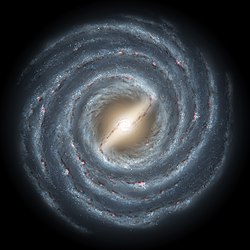Pisces-II-Zwerggalaxie
| Galaxie Pisces-II-Zwerggalaxie | |
|---|---|
| AladinLite | |
| Sternbild | Fische |
| Position Äquinoktium: J2000.0, Epoche: J2000.0 | |
| Rektaszension | 22h 58m 31s[1] |
| Deklination | +05° 57′ 09″ [1] |
| Erscheinungsbild | |
| Morphologischer Typ | dSph |
| Helligkeit (visuell) | 16,3 mag [1] |
| Winkelausdehnung | (2,2 ± 0,2)′ [1] |
| Physikalische Daten | |
| Zugehörigkeit | Lokale Gruppe |
| Entfernung | 585.000 Lj / 180.000 pc |
| Absolute Helligkeit | −5 mag |
| Geschichte | |
| Entdeckungsdatum | 2010 |
| Katalogbezeichnungen | |
| Pisces II[1][2] | |
Die Pisces-II-Zwerggalaxie (kurz auch Pisces II) ist eine linsenförmige Zwerggalaxie im Sternbild der Fische und wurde im Jahr 2010 in der Durchmusterung des Sloan Digital Sky Survey entdeckt[1].
Eigenschaften
Größen
Die Galaxie befindet sich in einer Entfernung von etwa 180 kpc von unserem Sonnensystem. Als spheroidale Zwerggalaxie besitzt sie eine annähernd runde Form mit einem Achsenverhältnis von 5:3 und einen Halblichtradius von lediglich 60 pc[1].
Leuchtkraft
Pisces II gehört zu den kleinsten und lichtschwächsten Satellitengalaxien unser Milchstraße. Die integrale Leuchtkraft entspricht mit der absoluten Helligkeit von MV = -5m etwa dem 10.000-Fachen der Sonne. Dies entspricht in etwa der Leuchtkraft eines durchschnittlichen Kugelsternhaufens.
Metallizität
Die Sternpopulation von Pisces II beinhaltet hauptsächlich ältere Sterne, die vor etwa 10–12 Milliarden Jahren entstanden sind. Die Metallizität dieser alten Sterne ist entsprechend gering mit [Fe/H] = −2,3, was gleichbedeutend ist, dass Pisces II in etwa 80-mal weniger an schweren Elementen besitzt als unsere Sonne[1].
Einzelnachweise
- ↑ a b c d e f g V. Belokurov, Walker, M. G.; Evans, N. W.; Gilmore, G.; Irwin, M. J.; Just, D.; Koposov, S.; Mateo, M. et al.: Big Fish, Little Fish: Two New Ultra-Faint Satellites of the Milky Way. In: The Astrophysical Journal. 712: L103, 2010. doi:10.1088/2041-8205/712/1/L103.
- ↑ SIMBAD Astronomical Database. In: Results for Pisces II. Abgerufen am 13. Februar 2010.
Auf dieser Seite verwendete Medien
Caption from NASA: Like early explorers mapping the continents of our globe, astronomers are busy charting the spiral structure of our galaxy, the Milky Way. Using infrared images from NASA's Spitzer Space Telescope, scientists have discovered that the Milky Way's elegant spiral structure is dominated by just two arms wrapping off the ends of a central bar of stars. Previously, our galaxy was thought to possess four major arms.
This artist's concept illustrates the new view of the Milky Way, along with other findings presented at the 212th American Astronomical Society meeting in St. Louis, Mo. The galaxy's two major arms (Scutum-Centaurus and Perseus) can be seen attached to the ends of a thick central bar, while the two now-demoted minor arms (Norma and Sagittarius) are less distinct and located between the major arms. The major arms consist of the highest densities of both young and old stars; the minor arms are primarily filled with gas and pockets of star-forming activity.
The artist's concept also includes a new spiral arm, called the "Far-3 kiloparsec arm," discovered via a radio-telescope survey of gas in the Milky Way. This arm is shorter than the two major arms and lies along the bar of the galaxy.
Our sun lies near a small, partial arm called the Orion Arm, or Orion Spur, located between the Sagittarius and Perseus arms.



